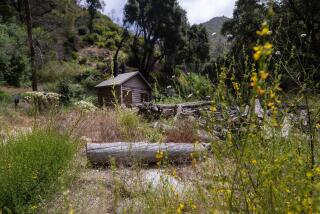He Clears the Air at U.S. Forest Restrooms
- Share via
There’s a stench out in them thar woods, and anyone who has ever paused at a campground, picnic area or rest stop in this country’s national forests knows precisely where it’s coming from.
That’s right, the public restroom.
Oh, they look innocent enough, painted in soothing earth tones to blend with the surrounding greenery. But these privies emit an odor not even the pungent scent of pine can disguise. One trip inside can quickly foul a visitor’s wilderness experience.
The U.S. Forest Service is well aware of the problem. Indeed, smelly toilets for decades have been the No. 1 complaint received by rangers from California to New Hampshire, top Forest Service officials say.
Now, for the first time, the federal government has a solution: After years of painstaking research, an engineer at a Forest Service laboratory in San Dimas has figured out why the toilets stink. And he has designed an odor-free model.
Administrators in Washington are overjoyed. They have formally declared 1990 “The Year of the Sweet-Smelling Toilet” and vowed to retrofit all 12,000 johns now in use on Forest Service lands. Another 300 new potties built annually, meanwhile, will incorporate the breakthrough findings.
Within three years, officials boldly pledge, Americans won’t find a single smelly latrine in any of their 134 national forests.
“The public today expects a higher level of service and more amenities, and part of that is a good-smelling toilet,” said Richard Woodrow, the Forest Service’s acting director of recreation. “Well, we’re going to give it to them.”
Achieving that goal will not be cheap. Costs are estimated at up to $1,500 apiece for the retrofits. But the toughest hurdle in the fragrant-toilet movement--solving the puzzle of why the things stink--has been cleared. And for that, credit must go to a man named Briar Cook.
Cook, 52, is a career Forest Service employee who has spent the last 17 years conducting research at the agency’s San Dimas Technology and Development Center. He has tinkered with picnic tables, barbecue grills and drinking fountains, and has hunted for ways to bear-proof garbage cans.
But toilets, Cook said matter-of-factly in a recent interview, have been his life’s work.
“Our society is funny about toilets--no one wants to talk about them,” he said, admitting that his calling subjects him to frequent teasing by friends. “But the odor problem affects a lot of people. As an engineer, I view it as a challenge.”
Indeed, unraveling this mystery has stumped many before him. Woodrow said gripes about smelly toilets have been common since the first outhouse was installed in a national forest in the early 1900s, and today’s visitors are even less tolerant--and more vocal--than their predecessors.
But the Forest Service has been unable to conquer the problem, despite experiments with chemicals, waste-eating organisms, flushable models and a variety of ventilation techniques.
Ultimately, most officials have reached a common conclusion: “We figured that toilets stink, period. Take it or leave it,” said Woodrow, who said his own wife has growled about the malodorous facilities during family vacations in the woods.
Cook, however, is one of those never-say-die kind of fellows, and so he kept at the toilet problem--even when supervisors advised otherwise. The engineer--whose silver hair and wire-rimmed glasses are reminiscent of a high school biology teacher--even built an experimental toilet in his laboratory.
Last year, Cook made a startling discovery: While examining a toilet in a Florida national forest, he found that cobwebs had clogged the compartment’s vent stack, preventing air--and thus odors--from escaping. A survey of toilet stacks in other forests revealed they, too, suffered from the spider web problem.
While the find sounds elementary, like something a custodian should have figured out years ago, Cook noted: “Nobody likes these little cabanas, so why would they go crawling around inside them? It’s in and out, as fast as possible. Nobody ever bothered to look in that stack.”
Other finds soon followed. Key among these was Cook’s discovery that the toilets’ basic design prevents effective ventilation. Through tests in an experimental wind tunnel, Cook determined that a wider vent stack stretching much higher above the roof line vastly improves the expulsion of odors. Also, he found, solar-powered fans help further to pull the fetid air from the chamber.
During a recent visit to the San Bernardino National Forest, Cook stood before a sorry looking privy at the Thurman Flats picnic area and talked about the state-of-the-art toilet of tomorrow. With obvious pride, he pointed to a vandal-proof toilet paper dispenser he designed in 1974, and revealed structural defects that still make this particular outhouse a stinker.
As he spoke, Forest Service janitor Philip La Voie, happened by.
“You have a very important job,” Cook told the man, “and soon you won’t have to put up with any more odors when you clean the toilets.”
La Voie wanted to hear more, so Cook launched into a detailed description of the recent technological advancements. He soon had his colleague shaking his head in awe.
“Sounds great,” said La Voie. “I like my job, but I sure don’t look forward to cleaning these things.”
Cook hopes ultimately to share his design with the National Park Service, the Army Corps of Engineers and other public lands managers, all of whom are plagued with smelly toilets.
More to Read
Sign up for The Wild
We’ll help you find the best places to hike, bike and run, as well as the perfect silent spots for meditation and yoga.
You may occasionally receive promotional content from the Los Angeles Times.






